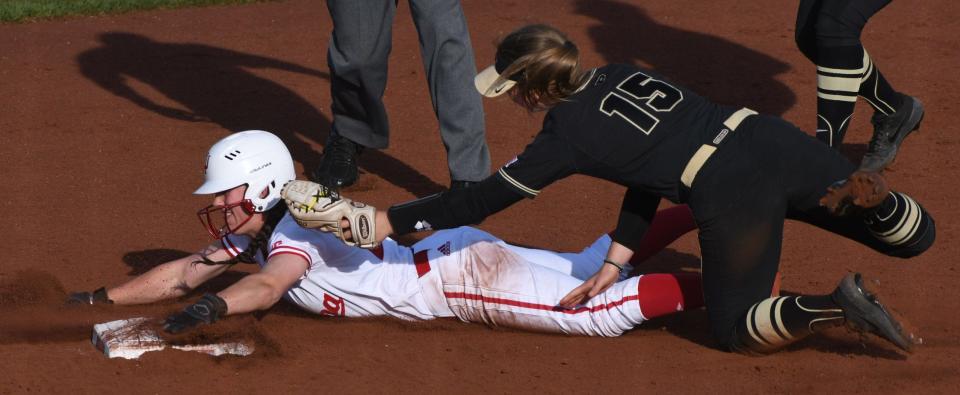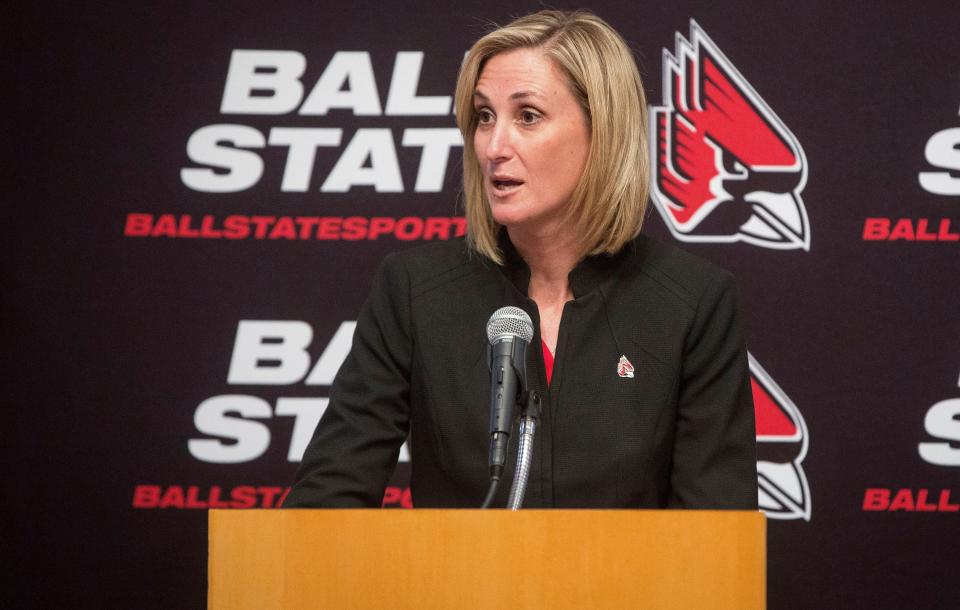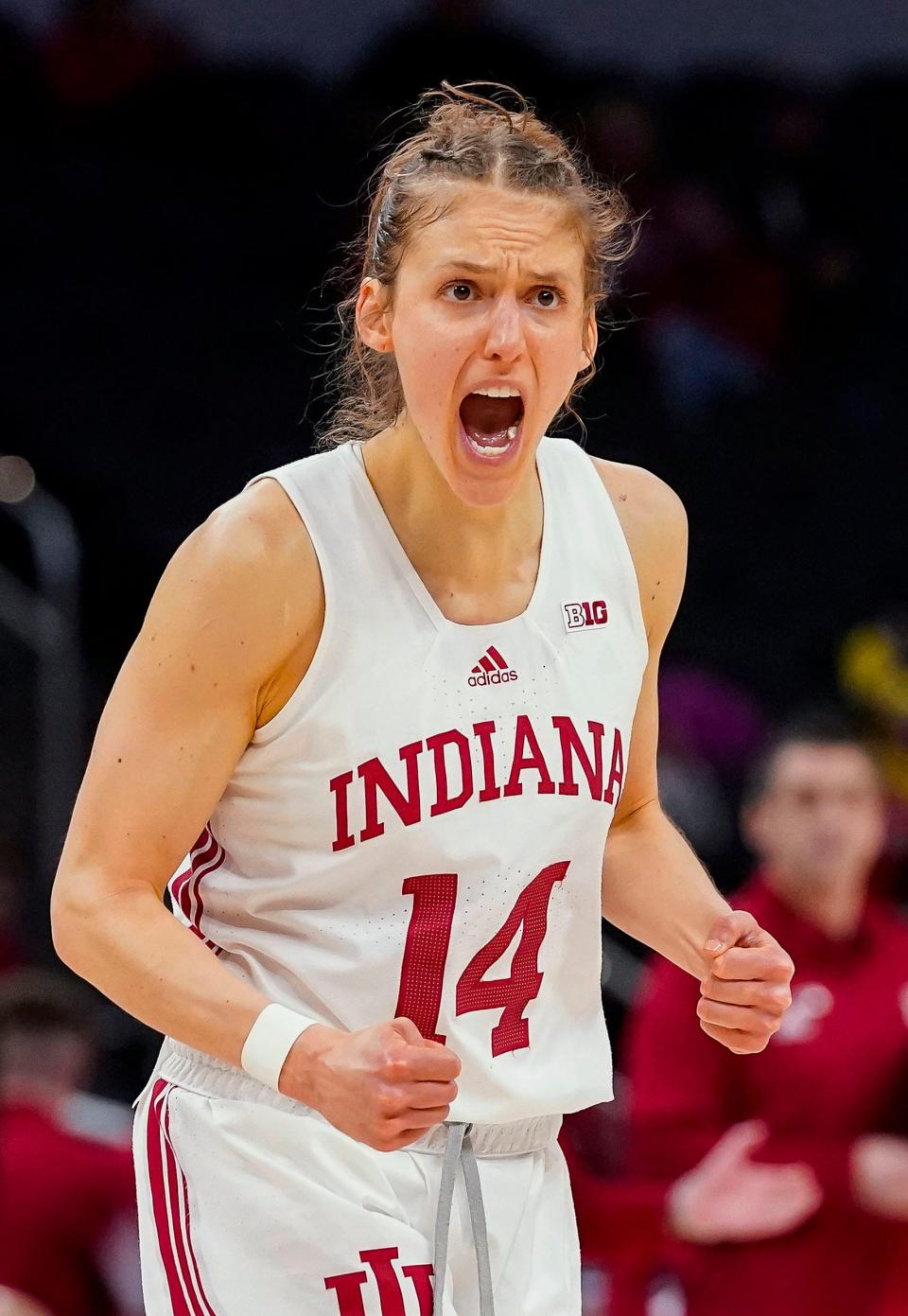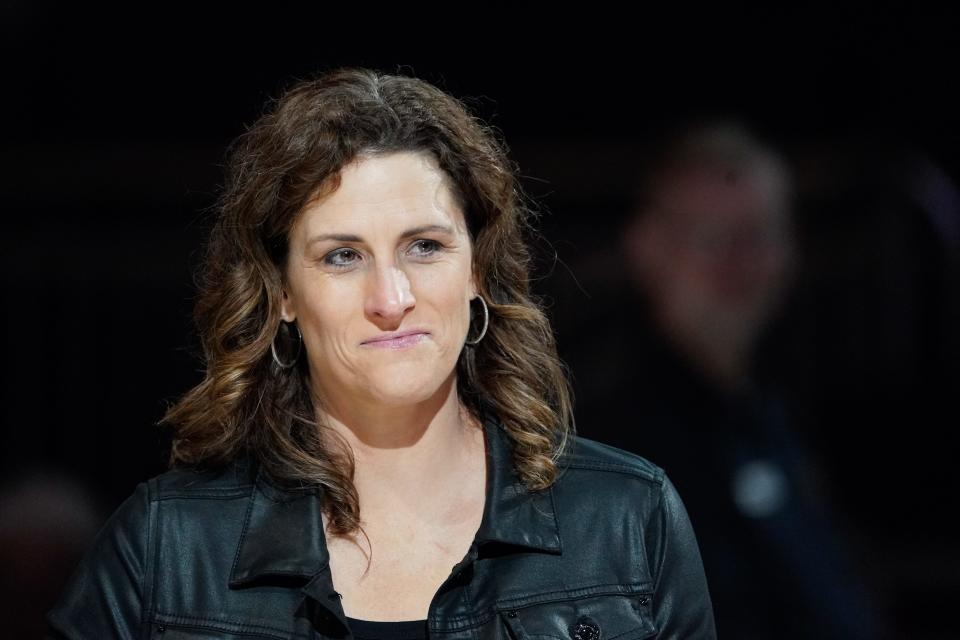Fast forward to 2072. What's next for gender equity in college sports?
Ask any coach or player about their experience as a woman involved in collegiate athletics, and they start with gratitude. They’re thankful for how far things have come since the early days, when their mothers and grandmothers never could have dreamed of playing college sports.
The problem is, that’s where they’re expected to stop.
“You see young women who are using their voices,” said Stephanie White, the 1995 IndyStar Miss Basketball winner who has coached the Indiana Fever and the Vanderbilt women’s basketball team. “Women are oftentimes made to feel like, ‘You should just be happy with what you have.’ We've come a long way, but there's still a long way to go.”
Title IX was implemented in 1972, and forever changed the world of sports for girls and women. But looking ahead to the next 50 years, there’s more to be done in the name of equality.
Creating a comprehensive to-do list would be a futile task. But here are some places to start:
Give women more coaching opportunities
Equity in Athletics Data Analysis tool
The trend is the same across all levels of the NCAA. According to The Institute for Diversity and Ethics in Sport’s 2021 Racial and Gender Report Card, women held 41.1% of head coaching positions for women’s teams across the three NCAA divisions.
“We're in an era where so many women have played, and I do think the best person should be hired for a job,” said Erica Hanrahan, DePauw University’s softball coach. “There are a ton of women out there that are so gifted, and if it were equal across the board where everybody was getting hired, that'd be wonderful. Many athletic departments still tip to the men's side — men get hired for men, but men and women get hired to coach women's sports. That's a discrepancy.”

Pay women coaches more
Across the 10 Division I schools in Indiana, the average salary for the coach of a men’s team is nearly $400,000. The average salary for the coach of a women’s team is just north of $100,000. While some of the discrepancy is due to the often sizable salaries of football coaches, there is still a gap between genders (especially when considering that men often coach women’s teams.) According to a study by the Journal of Sports Economics, “Earnings Gap Between Male and Female NCAA Division I Basketball Coaches,” “Women’s head coaches of either gender earn about 50% of the base salary of the average men’s head coach.”
The numbers are trending in the right directions. IU women’s basketball coach Teri Moren signed an extension in April 2021 that will pay her $862,500 per year, among the top earners in the Big Ten.
Fund women’s sports equally
Athletic departments often spend a disproportionate amount of money on men’s sports versus women’s sports. Using information from the latest Equity in Athletics Data Analysis, IndyStar found that the 10 Division I schools in Indiana spend an average of $3.4 million annually on men’s sports and $1.8 million on women’s sports (as expected, IU, Notre Dame and Purdue had the biggest discrepancies due to their football programs). A USA Today analysis found that, of the 107 schools analyzed, schools spend $25 million more on men’s equipment than women’s equipment, $22 million more on recruiting and $77 million more on travel expenses. The data were from the 2018-19 and 2019-20 fiscal years.

Locally, Purdue and Ball State spent nearly twice as much on equipment for its baseball team than its softball team. Ball State attributed the discrepancy to a number of factors — one-time equipment purchases for the baseball team, a difference in price for the same product between baseball and softball, and baseball using a higher volume of balls per game. Purdue did not respond to a request for comment about the discrepancy in spending between the teams.
As expected, Indiana spent five times as much on recruiting for men’s basketball than women’s basketball. In 2019, IndyStar reported that IU reported more than $3.5 million in recruiting-related expenses from 2013-2018. Kentucky was the only other school to spend more than $3 million on recruiting in that span.
Indiana spent twice as much on travel for its men’s soccer team than its women’s soccer team, which Senior Associate AD Jeremy Gray attributed to the men’s trip to the College Cup in 2020.
Put more women in leadership positions
Women continue to lag behind men when it comes to leadership positions within athletic administrations and the NCAA. The Institute for Diversity and Ethics in Sport’s 2021 Racial and Gender Report Card showed that just 33% of NCAA athletic conference commissioners are women. The study found that 32.4 percent of Division I associate athletics director positions were held by women during the 2020-21 fiscal year (40.9 percent in Division II, and 47.9 percent in Division III). Numbers were similar for assistant athletic directors.

Beth Goetz (Ball State) and Kelley Hartley Hutton (Purdue Fort Wayne) are the only female athletic directors among Division I schools in Indiana. Hutton has been in her role since 2014, while Goetz has been Ball State’s athletic director since 2018.
“I just think it’s a great responsibility to have this opportunity and for young women to be able to say that they would like to maybe serve in this role as well,” Goetz said when she was hired.
Give women more NIL opportunities
The introduction of compensation for college athletes from name, image and likeness deals has opened up new opportunities — and most of them are being taken advantage of by men.
According to Opendorse, a NIL company, football players account for 49.9% of NIL compensation. Men’s basketball players are next with 17%. Women’s basketball players trail behind at 15.7%, and there’s a substantial drop-off to women’s volleyball at 2.3%.
Opendorse says that men’s sports account for 73.5% of compensation from NIL deals, while women’s sports account for 26.5%.
The March Madness debacle that can’t happen again
The 2021 NCAA basketball tournament was always going to be different, with the women’s bubble in San Antonio and the men’s bubble in Indianapolis due to COVID concerns. But the way it transpired brought disparities between men and women to light.
'Can't be a flash in the pan': A TikTok made women's basketball equality go viral. What's next?
A TikTok from Oregon star Sedona Prince showed the “weight room” the women were given — a set of 12 hand weights — compared to the state-of-the-art men’s weight room the men had access to.
“When we saw the weight room, we were kind of like, ‘Is that it? There has to be more,’” former IU player Ali Patberg told IndyStar in November. “When we saw what the men had, it just brought to light the differences. We always want to stay grateful and thankful for what we have, but to see the differences was kind of like, ‘Whoa.’”

The discrepancies didn’t stop there. There were differences in food quality and COVID testing (men underwent daily PCR testing, while the women underwent daily antigen testing and just one PCR test per week).
“The food we were fed was not meeting our expectations like what we saw on the men's side,” said Sydney Parrish, who played at Oregon for two seasons before transferring to Indiana. “We weren't getting the right nutrition.”
Muffet McGraw, the legendary Notre Dame women’s basketball coach, wasn’t surprised by what she saw.
"Most women and coaches who have been in the game as long as I have are tired of it,” she said. “We've been treated poorly for years. The culture at the NCAA has always put the men before the women.”
The NCAA asked Kaplan Hecker & Fink LLP to investigate what led to the differences in the two tournament experiences. The findings of the investigation were published in the NCAA External Gender Equity Review on Aug. 2, 2021, and revealed that there are “underlying, systemic gender equity issues at the NCAA” which “must be remedied if the goal of equitable treatment of student-athletes is to be achieved.”
In addition to shining a light on what happened during the NCAA tournament two years ago, it shed light on issues that went deeper — and put women at a disadvantage.
"The primary reason, we believe, is that the gender inequities at the NCAA — and specifically within the NCAA Division I basketball championships — stem from the structure and systems of the NCAA itself, which are designed to maximize the value of and support to the Division I Men’s Basketball Championship as the primary source of funding for the NCAA and its membership," the report said.
Put women in primetime
The Gender and Equity report highlighted disparities in the television deals between the men’s and women’s NCAA tournaments. The NCAA’s contract with CBS and Turner to broadcast the men’s tournament currently pays the NCAA $850 million, while ESPN’s deal to broadcast the women’s tournament brings in approximately $34 million (and is part of ESPN’s deal with rights to air the championships of all 29 other NCAA sports.)
ESPN broadcast more than 330 women’s college basketball games during the 2021-22 season. But some of those were on channels not readily available, like conference networks.
The 2022 national championship game between South Carolina and UConn saw the largest TV audience for the event since 2004. ESPN said the tournament averaged 634,000 viewers per game, up 16% from a year ago.

“When you place women's sports in positions to be successful instead of putting them in positions to just exist, we see the results,” White said. “We saw that with television ratings. We see that with programs and universities where presidents and athletics departments have made investments in coaches and resources. In my mind, it's the priority of truly investing in women's sports as opposed to just because we have to.”
The 16 games of this year’s women’s college softball tournament averaged 1 million viewers, according to ExtraInnings Softball, after a record 1.2 million viewers last year. By comparison, the men’s College World Series in 2021 averaged 755,000 viewers.
Heading into the college softball season, an ESPN press release boasted that the network and its affiliates would air “1,900 matchups across its digital networks.” However, most of these were shown on conference networks (SEC Network, ACC Network, Big 12 Now on ESPN+, Longhorn Network). Fewer than 60 regular-season games were shown on ESPN, ESPN2, ESPNU or ESPNews.
Keep celebrating successes and striving for more
Shonda Stanton is the ninth coach in the nearly 50 years of Indiana's softball program. When she thinks about what's next, she thinks about how far the sport has come.
"I'm standing on the shoulders of the women that have come before me," she said. "It's celebrating them, acknowledging what they have accomplished and achieved, and then it’s, ‘What can I do to leave it better for the 10th coach in the history of Indiana softball?’"
Discussing what needs to happen next in terms of gender equity, she mentioned less about disparities and more about improvements. A rule change altered this year's women's College World Series from a seven-day event to a nine-day event. Stanton would like to see doubleheaders in the semifinals eliminated, to lower the risk of injuries.
This has nothing to do with what men have and women don't. It's merely about making the women's game the best it can be.
"We need to evaluate everything that we're doing, and where we can be better," she said.
Hanrahan, who just finished her ninth season as DePauw's softball coach, says she'd like to see an increase in the number of softball roster spots allowed during the NCAA tournament events (currently at 20). College baseball rosters are allowed 25 players during the tournament, due in part to the higher number of pitchers used.
"Athletes here are playing for the love of the game," Hanrahan said. "Come playoff time, kids are told they can't be in uniform, or they have to sit, and or they have to be out of the dugout. The rosters need to be on par with men's and women's sports across the board."

White mentioned issues she's heard from her coaching colleagues: Struggling for time at practice facilities, getting adequate access to weight rooms and experiencing travel discrepancies.
They're little things, but equality could make a big difference. And she says it's critical to keep talking with players — about where they've been and where they want to go.
"It's important for us to help them understand where we've come from, who has been on the frontlines of this movement, and see the journey as a whole, not just where we are right now," White said. "What can we do to put plans in motion, and actively participate in the progress, as opposed to just talking about it? That's really the next step in the message for our young people."
Follow IndyStar trending and enterprise sports reporter Matthew VanTryon on Twitter @MVanTryon and email him story ideas at matthew.vantryon@indystar.com.
This article originally appeared on Indianapolis Star: Title IX changed women's sports. What's next for NCAA equity?

